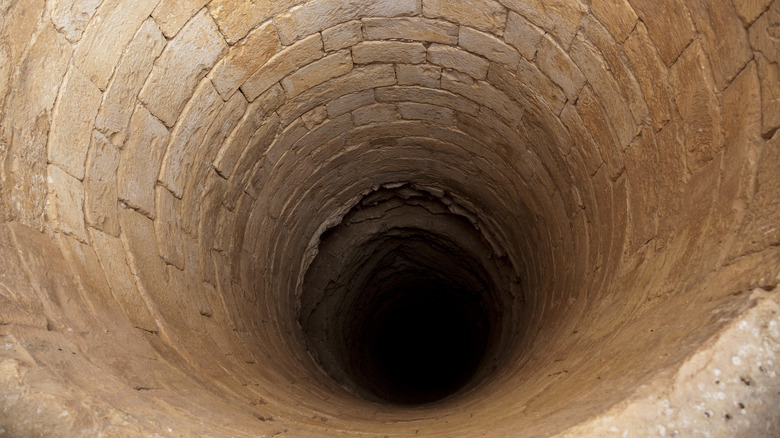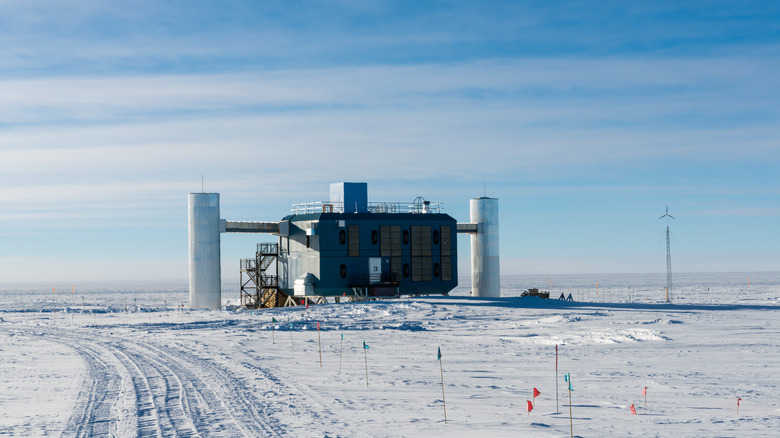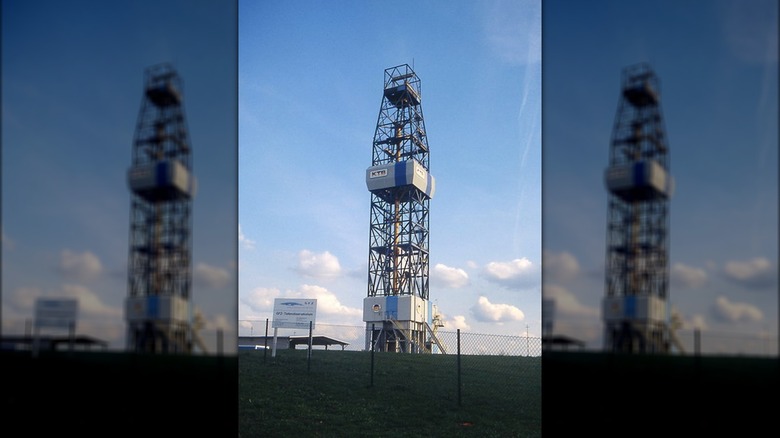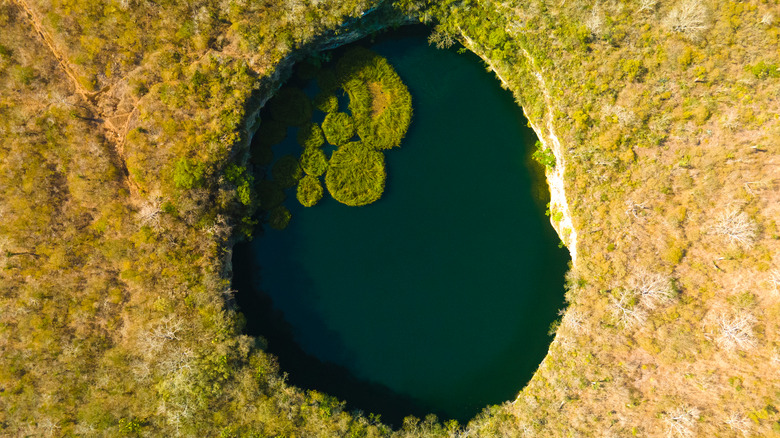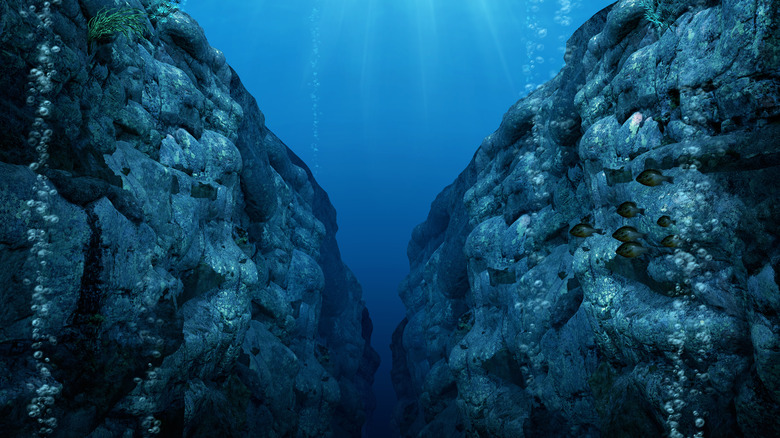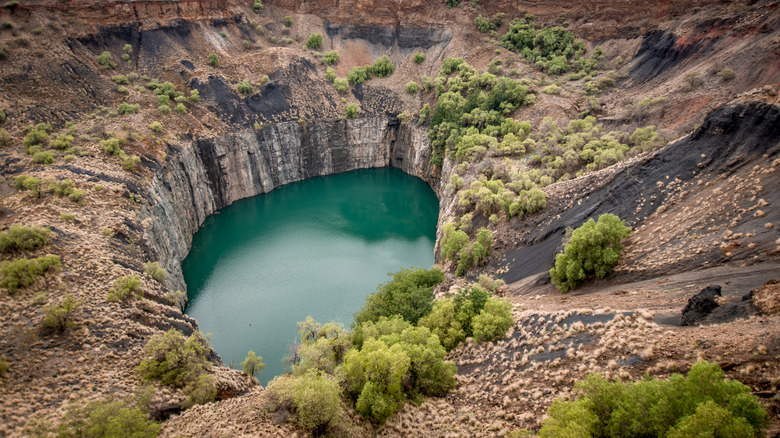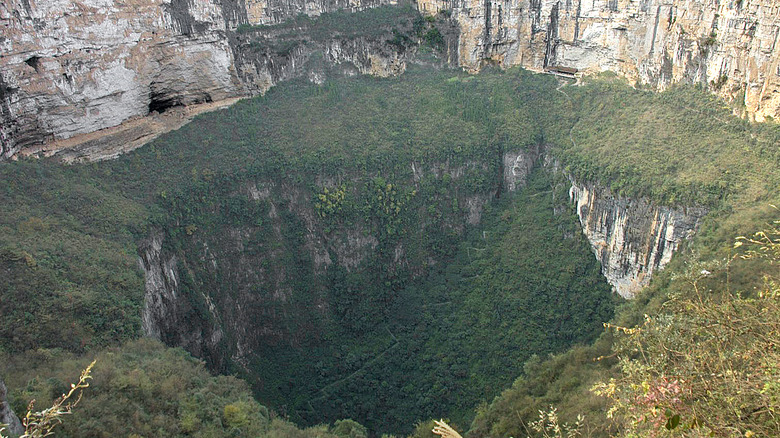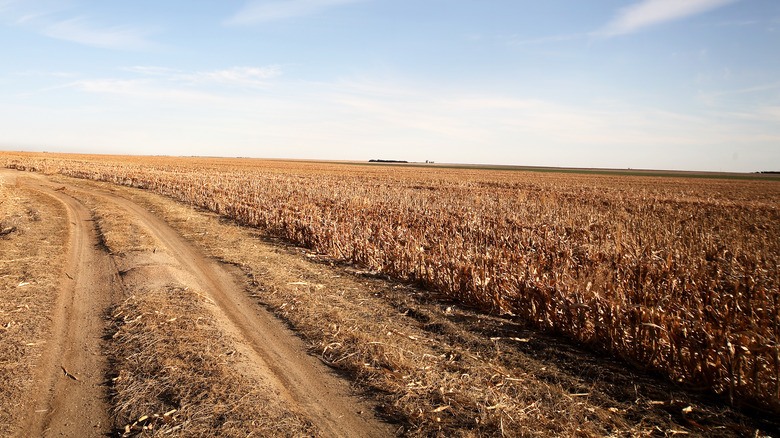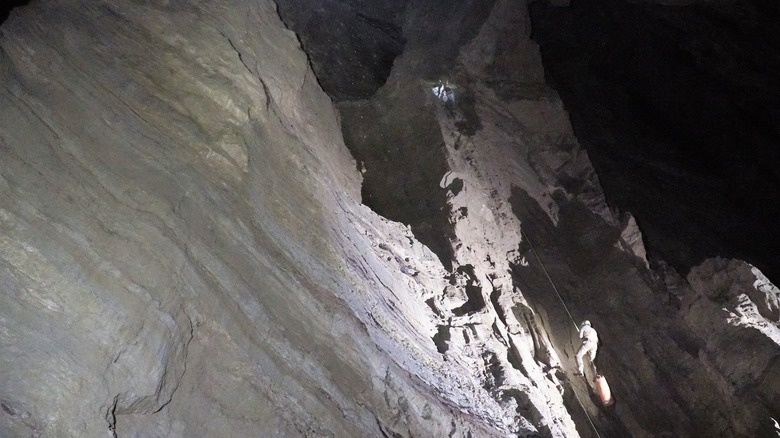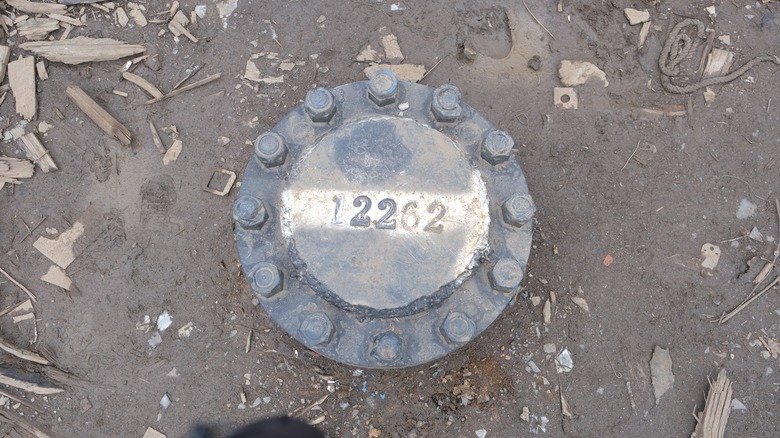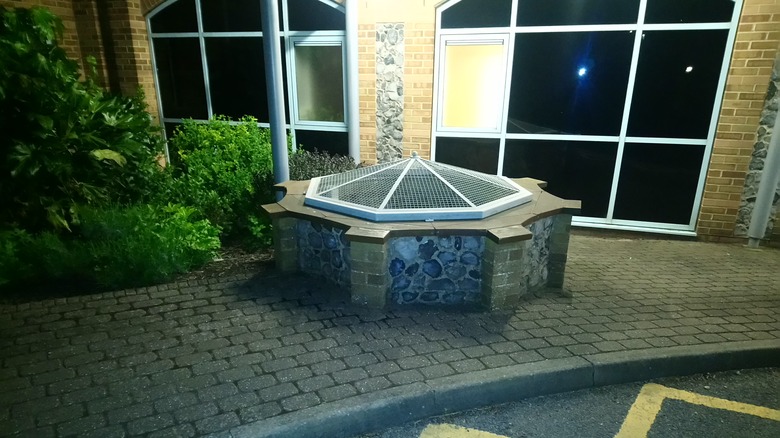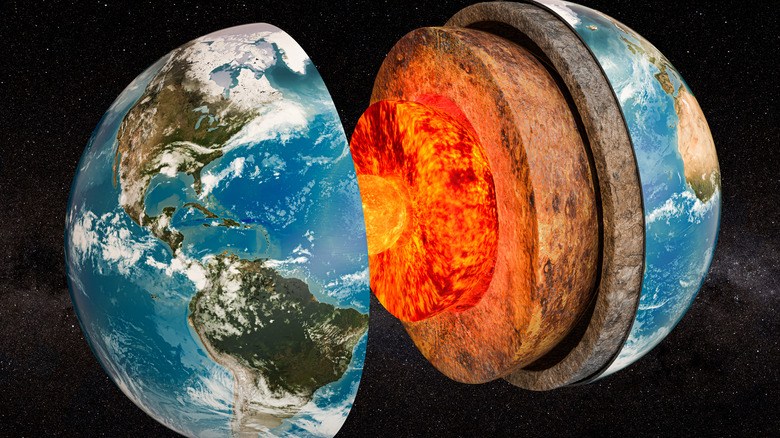The Deepest Holes In The World
In more ways than one, it's easier to go into space than to dig a really deep hole. Space is easy because it's empty, while every mile down into the crust results in more and more pressure and rising temperatures. But despite these challenges, humans have found themselves capable of making some of the deepest holes in history.
Humans aren't the only ones capable of creating deep holes. The Earth itself has a remarkable capability to create a variety of holes on both land and sea. Sometimes the holes end up being filled up, whether by rain or by rocks. Other times, the holes remain as vast chasms. But the most remarkable thing about these holes is that no matter where they're made, life is always found in them, regardless of the depths they reach.
And no matter if the hole is natural or man-made, people are always interested in knowing what's at the bottom. At this point, it's hard to find a hole that hasn't already been explored. But as technology continues to advance, more and more holes will be made and they will go deeper and deeper. While humans have yet to hit the Mohorovičić discontinuity, it's really only a matter of time. These are the deepest holes in the world.
IceCube Neutrino Observatory, Antarctica
While some telescopes sit on land and gaze up at the stars, the IceCube Neutrino Observatory in Antarctica reaches between 5,000 and 8,000 feet underground, over 1.5 miles. Reaching deep down into the ice, the IceCube Observatory seeks to observe evidence of neutrinos as they pass through the Earth. However, the neutrinos themselves aren't what is being observed. The IceCube Conservatory watches the ice and looks out for Cherenkov light that is emitted when neutrinos pass through the ice.
Over the course of six years, the IceCube Observatory was created out of 86 boreholes that were made using both pressurized hot water and drilling rather than being one big hole, within which hang digital optical modules (DOMs) on strings that are used to detect evidence of neutrinos. And according to "New Eyes on the Universe" by Stephen Webb, while the strings in the boreholes will only detect neutrinos for about 25 years, the strings will remain in the ice for up to 25,000 years.
Since its completion in 2010, the IceCube Observatory has detected evidence of dozens of neutrinos. Some of them have even been named after the characters from Sesame Street. And in November 2022, Science reported that the IceCube Observatory observed evidence of neutrinos that came from another galaxy, the second time ever that this has been observed.
KTB Borehole, Germany
From 1990 to 1994, the Federal Republic of Germany dug the Kontinentales Tiefbohrprogramm der Bundesrepublik Deutschland, also known as the German Continental Deep Drilling Programme or the KTB borehole. The KTB borehole was dug in order to study the depths and processes of continental crust and is technically composed of two deep boreholes, a pilot hole and an ultra-deep main hole, the latter of which reaches depths of 30,000 feet, over 5.6 miles. And with the borehole, scientists have been able to amass a great deal of geothermal data and research that they would have been unable to acquire from merely surface observations.
In order to reach depths never before reached on continental crust, the largest land rig in the world was used. This project was also the most expensive geo-research program Germany had ever undertaken, costing roughly $350 million at the time. At the time it was dug near Windischeschenbach, Bavaria, it was the deepest borehole in the world, reaching depths of almost 30,000 feet. And at the bottom of the borehole, temperatures rise to over 500°F, and the pressure is over 94,000,000 Pascals. Although the Kola Superdeep Borehole reached depths even further than the KTB borehole, the KTB borehole remains the deepest borehole in the world that is still in use. In 2023, GFZ Potsdam began the GEOREAL project to study crystalline rock during hydraulic stimulation.
[Image by Christian Lipp on geo.hlipp.de via Wikimedia Commons | Cropped and scaled | CC BY-SA 2.0]
El Zacatón, Mexico
In the east of Mexico in Aldama, Tamaulipas is an especially unique hole. Known as El Zacatón, this sinkhole is the deepest water-filled sinkhole on Earth. For years, no one knew exactly how deep the geothermal sinkhole was since no one had ever managed to reach the bottom. It wouldn't be until 2007, when a NASA-funded exploration robot, known as Deep Phreatic Thermal Explorer (DEPTHX), found that the bottom of the sinkhole reached a depth of over 1,000 feet. The technology used by NASA to explore El Zacatón will also hopefully be used one day in the future to explore Jupiter's moon Europa.
The exploration discovered that in addition to its staggering depths, El Zacatón was unique in that it wasn't connected to any of the other nearby water-filled sinkholes in any way. And in 2010, DEPTHX discovered that at the bottom of the sinkhole is an incredible diversity of microbial life, at depths that not even sunlight can reach.
The depths of El Zacatón have always attracted divers and thrillseekers. In 1993, Dr. Ann Kristovich set a women's world record by diving to over 550 feet in El Zacatón, and in 1994, cave diver Sheck Exley died during a dive to find the bottom of El Zacatón.
Mariana Trench, Pacific Ocean
Not all of the deepest holes can be found on land. With a depth of over 36,000 feet, the Mariana Trench is the deepest point in all of the oceans on Earth. But unlike the similar depths that people have dug down to on land that reach scalding temperatures, the depths of the Mariana Trench are quite cold, reaching temperatures of 34°F. But the temperature isn't the problem, it's the pressure. At the bottom of the Mariana Trench, over 6.8 miles down, the pressure is up to 108,600,000 Pascals, which is over 1,000 times the atmospheric pressures experienced at sea level.
Located in the western Pacific Ocean near Guam, as of 2023 only six people have reached the bottom of the Mariana Trench. This part of the ocean, the deepest part, is known as the Hadal zone and is named after the Greek god of the underworld Hades. After the depth was first measured in 1875, it would take almost an entire century for divers to reach the bottom themselves in 1960. But despite the fact that few humans have physically been to the bottom of the Mariana Trench, man-made chemicals like PCBs and PBDEs have already taken up residence in the ocean depths.
Despite being in the Ring of Fire where there's constant seismic activity, the Mariana Trench continues to maintain itself as the deepest hole in the ocean.
Big Hole, South Africa
While some of the deepest holes on Earth are naturally occurring or have been dug with machines, the Big Hole in Kimberley, South Africa, was excavated by hand. Also known as the Kimberley Mine, the Big Hole is considered to be one of the deepest hand-dug excavations in the world, although the Jagersfontein and Bultfontein diamond mines may potentially have even deeper hand-dug portions, reports News24.
Reaching a depth of over 2,600 feet and taking up over 40 acres, the Big Hole was dug up for diamonds during British colonization. And while 2.7 tons of diamonds would eventually be excavated, the African workers who mined for the diamonds faced staggeringly high mortality rates in the process. Robert Vicat Turrell writes in "Capital and Labour on the Kimberley Diamond Fields, 1871-1890" that even when the death rate at the Kimberley mine fell, it was still around 6.2 people per 1,000. And it wasn't just the mining itself that was dangerous. In the early 1880s, a smallpox epidemic was allowed to run rampant, known as the "Kimberley Mines Scandal," and led to 700 deaths in Kimberley, the vast majority of whom were African workers.
After being dug for 50 years, the mine closed in 1914 and has since turned into a tourist attraction and is the most popular tourist attraction in Kimberley, South Africa.
Xiaozhai Tiankeng, China
Sinkholes exist all over the globe, but Xiaozhai Tiankeng in China is known for being the largest and deepest sinkhole in the world. Also known as the Heavenly Pit, Xiaozhai Tiankeng is up to 2,200 feet deep and has a volume of 4.2 billion cubic feet, and at the bottom leads into the Difeng cave.
Tiankengs are like other sinkholes except for the fact that they are created in carbonite rock or sandstone. And in addition to needed specific geologic conditions, the area needs to be above sea level and experience heavy rainfall. Because such specific conditions are necessary for the formation of tiankengs, there are less than 100 identified tiankengs in the world, with 50 of them in China alone.
Xiaozhai Tiankeng is believed to have formed over the course of the past 128,000 years and became the gigantic hole that we know today when its ceiling collapsed. But compared to the other tiankengs in the area, Xiaozhai Tiankeng is relatively young.
Bertha Rogers, USA
In 1974, the Lone Star Producing Company dug the Bertha Rogers hole, which at the time became the deepest borehole in the world until it was surpassed by the Kola Superdeep Borehole. Reaching depths of 32,000 feet deep, or roughly 6 miles down, Bertha Rogers dug to find natural gas reserves in the Anadarko Basin in Oklahoma, United States. And although it may no longer be the deepest borehole in the world, it remains the deepest borehole in the United States.
Drilling started in 1972 and was done by the biggest land rig in the world at the time, but within two years Bertha Rogers hit a wall, so to speak. Not unlike a wall of liquid mustard gas, in April 1974, Bertha Rogers hit liquid sulfur while it was drilling, which melted the drill bit, and sulfur doesn't melt until it experiences temperatures close to 250°F. And in addition to the liquid sulfur, the dig also encountered pockets of hydrogen sulfide.
But despite the fact that Bertha Rogers was dug with the intention of finding natural gas reserves, there was little natural gas to be found, considering the $7 million that was invested into the digging of the hole. Bertha Rogers continued to produce natural gas until 1997, but it has since been abandoned and remains just a giant hole in the ground.
Veryovkina Cave, Georgia
While one may not initially think of a cave as a traditional hole, a cave is nothing if not just a long windy hole. And in Georgia, Veryovkina Cave holds the title of the deepest-known cave in the world. With a depth of over 7,000 feet, equivalent to over 1.3 miles, Veryovkina Cave is known as the Everest of the Deep because of its phenomenally steep descent into said deep, per ZME Science, making it significantly more hole-like than over caves.
The bottom of Veryovkina Cave wasn't reached by people until March 2018 by Russian cave divers Pavel Demidov and Ilya Turbanov, and it was only then that Veryovkina Cave became known as the deepest cave in the world, demoting Krubera Cave, also in Georgia, to second-deepest. And even within this cave, scientists continue to make new observations, such as the discovery of a new species of ground beetle.
But although exploring the cave can be incredibly appealing, venturing to the bottom can be incredibly precarious due to the dangers of flooding. And in 2021, Russian climber Sergei Kozeev was found dead in the cave after disappearing while cave diving the previous year. However, it's unclear if Kozeev died from hypothermia or falling.
[Image by Petr Lyubimov via Wikimedia Commons | Cropped and scaled | CC BY-SA 4.0]
Kola Superdeep Borehole, Russia
Although humans have dug their fair share of deep holes, few rival the Kola Superdeep Borehole, which as of 2023 continues to be known as the deepest borehole on Earth. Dug from 1970 to 1992 in Murmansk, Russia, the Kola superdeep borehole was initially supposed to reach depths of 50,000 feet. But by 40,000 feet, over 7.5 miles down, the temperatures were over 356°F and the drill bit wasn't even able to function at such high temperatures. And at these temperatures, the rocks were so malleable that scientists compared them to plastic.
Additionally, the depth that the Kola Superdeep Borehole reaches is considered to be the deepest artificial point in the world, because, despite the fact that other boreholes may technically be longer, the Kola Superdeep Borehole goes the deepest into the crust. In this regard, the Kola Superdeep Borehole fulfilled its research goal of digging down into the Earth's crust as far as possible. But after encountering the incredibly hot temperatures, the project was abandoned and the Kola Superdeep Borehole was sealed from the top.
But despite eventually being sealed up, the Kola Superdeep Borehole yielded a great deal of scientific discoveries. Deep down in the crust, scientists found both water and fossils of single-celled organisms. Plus, other scientific theories had to be revised, such as the temperature estimates of the Earth and the belief of a worldwide Conrad discontinuity, a geological boundary that was thought to exist throughout the world.
Woodingdean Water Well, United Kingdom
Some of the deepest holes may actually be the most inconspicuous, as is the case for the Woodingdean Water Well in Woodingdean, United Kingdom. Dug from 1858 to 1862, the Woodingdean Well is the deepest hand-dug well in the world. And while its depth of 1,285 feet may not seem impressive compared to the digs of the 20th century, it was certainly an impressive feat at the time. Especially since they never expected to go that deep.
The Woodingdean Well started being dug in order to provide water for the recently built workhouses and industrial schools nearby. But even when years of digging yielded no water, the sunk cost fallacy persuaded people to simply keep digging. By the time the Woodingdean Well was completed, it had become an exceptionally expensive project, costing taxpayers up to £90 a week, equivalent to over $18,085 today.
But even though digging the Woodingdean Well was expensive, it was only used for four years and was soon replaced by another water-procuring method. The Woodingdean Well can still be seen by Nuffield Hospital, but its legacy largely remains as being a deep hole in the ground.
[Image by Yiorgos Stamoulis via Wikimedia Commons | Cropped and scaled | CC BY-SA 4.0]
Project Mohole, Pacific Ocean
Some holes start off strong, but inevitably flounder but never get to hit a hole in one. And that's exactly what happened with Project Mohole, an American attempt during the 1960s to reach the Mohorovičić discontinuity. From 1961 to 1966, the American government started digging a hole in the Pacific Ocean off the coast of Guadalupe Island, Mexico, known as Phase I.
Although there were supposed to be Phases II and III, in 1966 the project was abandoned. But during Phase I, Project Mohole dug a hole that reached over 600 feet below the seafloor. Although this was nowhere close to the Moho Discontinuity, which is considered to be about 4.5 miles under the ocean's crust, it was the most valiant attempt that had ever been made. And even before the project was shut down, Project Mohole yielded a number of interesting discoveries, including the age of part of the crust as well as never-before-seen samples.
And despite its overall failure, Project Mohole provided the tools for further oceanic research and exploration. Vox writes that without Project Mohole, fields like paleoceanography may not have started as they did and that is why many scientists consider Project Mohole to have been absolutely worth it regardless of its untimely demise. Despite never reaching the depths it dreamed of, Project Mohole ultimately deepened everyone's imaginations.
